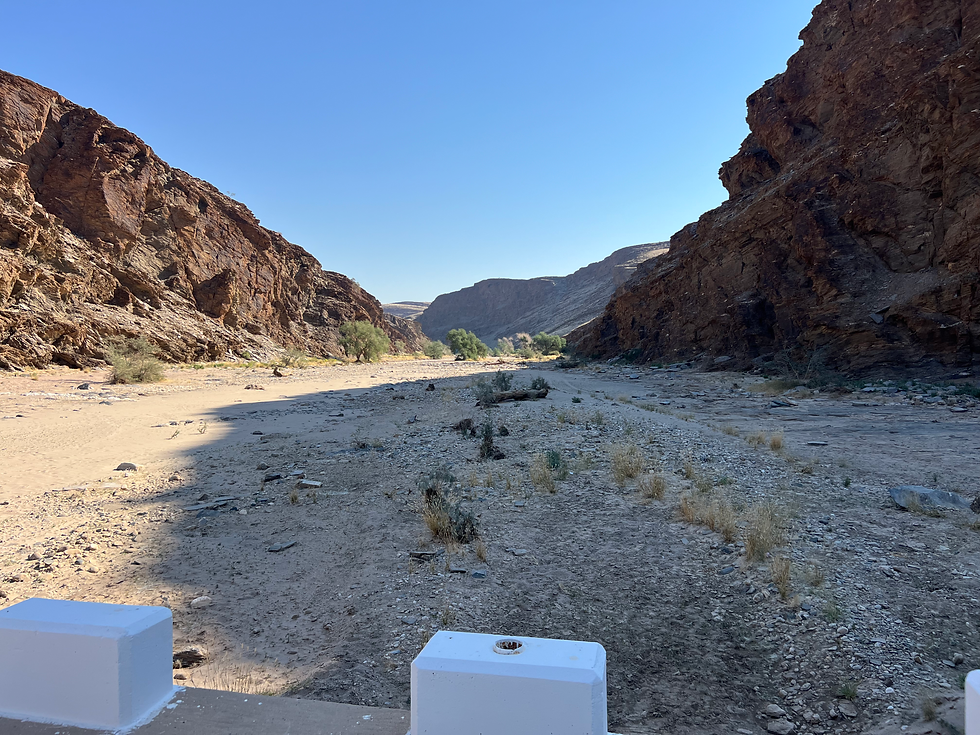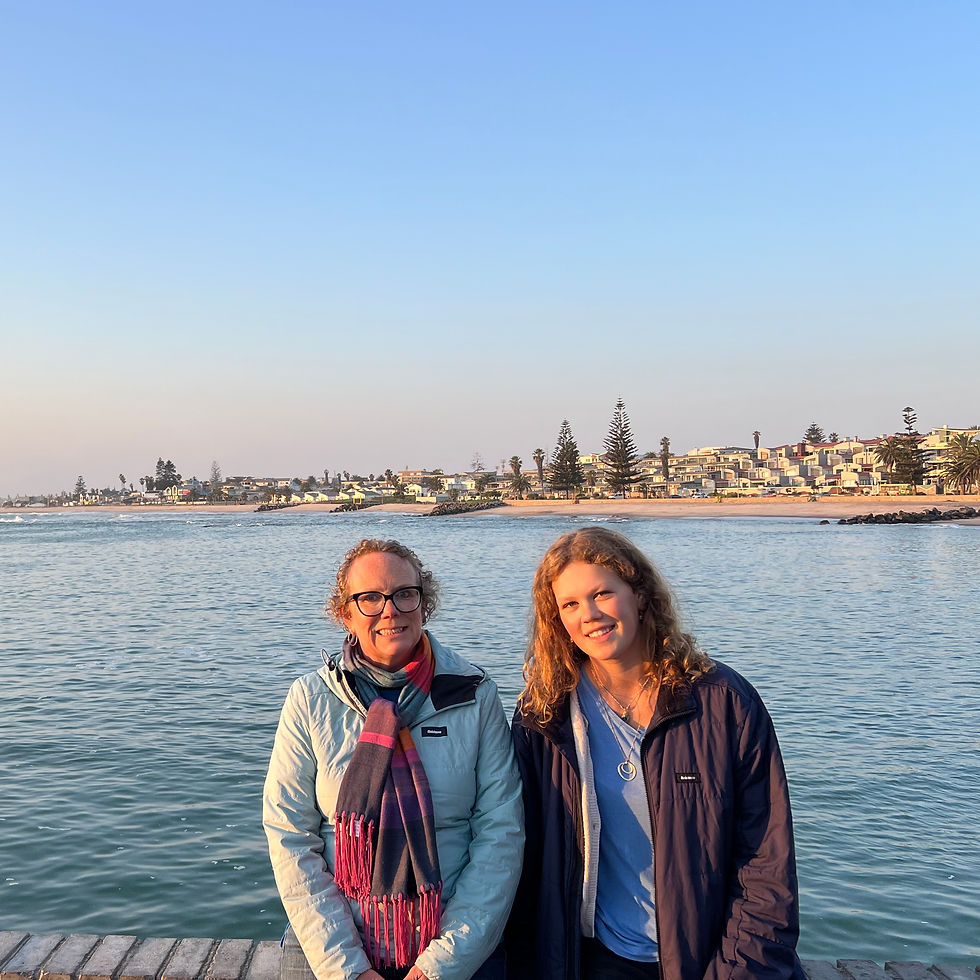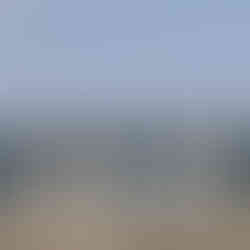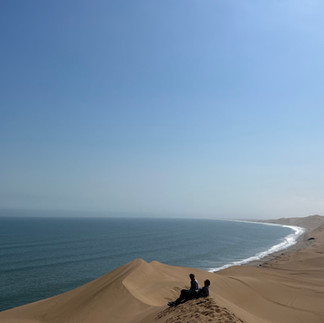Namibia part 4: down to the sea
- guymavor
- Aug 23
- 9 min read
It is 60km to the coast from Sossusvlei as the crow flies, but I doubt it would make it. We go the long way round, nearly 400km, to Swakopmund. The Namib dune sea is not hospitable, although it is endlessly beautiful, especially on its eastern edge, after this year’s late rains produced so much grass.

After two hours of increasingly juddery driving on a rutted road (the graders can’t keep up with the volume of traffic these days), we stop for fuel at Solitaire. The place is photogenic and weird, with the shells of old cars sitting in a patch of straw-coloured grass by a couple of cafes next to a lodge and campsite. Everyone stops here, so it is ‘crowded’ too – there are literally dozens of people. Moose McGregor’s apple pie is the draw: famous but very much resting on past glories. I wouldn’t bother, but filling up your tank is a must.
As we drive on, the landscape changes, with red sand less apparent and black rock prominent, its harshness softened by pale grasses this year. We travel through the endless shallow gullies of the Kuiseb river basin, crossing the river but missing the turning to one of Henno Martin’s wartime shelters, a simple cave, in the Kuiseb canyon itself. I visited it in 2002 but it is no longer signposted, so we drive on. With a bit more time, we would have gone looking for it as he is fascinating, even if the cave is not much to look at.

He and a friend, Hermann Korn, both geologists and pacifists, hid in the desert and lived off hunting for two years rather than be interned by the South African / British authorities, as Germans were. Martin, who discovered the Messum crater in 1939, site of Earth’s largest ever volcanic eruption, worked as director of the Geological Survey of Namibia for 20 years from the 1960s on, having been a freelance geologist, consulting on boreholes, including Windhoek’s first large-scale potable water source, after the war. He also headed departments at Cape Town and Göttingen universities. Namibia is a geologist’s dream, and so much of our understanding of it is built on his work. Martin is also an excellent writer. His account of those two years in the Namib, the Sheltering Desert, is still in print. I highly recommend it.

The ruts gradually smooth out as we get past the Kuiseb canyon, and we find ourselves on a salt road, which is not quite tar but still blissfully smooth. At Walvis Bay, we join the new, inland four-lane highway for the last stretch to our guesthouse in the south of Swakopmund (first impressions: quiet as ever), which seems straight out of the UAE, apart from the fact that it’s empty.
The next day we head back south on the coast road with our guide and host from Turnstone tours, Rudi, who is excellent company. We are heading for Sandwich Harbour, and points in between. With us are Anthony and Michelle, a French designer and his mum, a retired notary, who are great fun and on an epic camping trip (or “4 days camping, two days lodges”) for 6 weeks, going from Windhoek to Victoria Falls via the Okavango and Chobe. Now that is taking your time, although they are travelling big distances, making it up to the Kunene and Kavango rivers at various points. We meet them again at Nhoma.
Walvis Bay was always a big, busy port, but the coastline between it and Swakopmund has been developed too. We pass Palm Beach, full of sea-view holiday homes, and a water park, closed for winter. More basic, mass housing has been added in the north of town. Rudi tells of similar expansion in Swakopmund, and sure enough, we discover later that it stretches 7km further up the coast than I remember, with malls and restaurants. The money has moved north and the old centre is quiet, seedy even at certain intersections where I am asked if I ‘want company’. No thanks, I came to Namibia for as little company as possible.
At Walvis Bay the lagoon is the attraction, with the city’s smartest neighbourhood alongside it. There is lots of life in these sheltered waters and in the cold Benguela current out in the Atlantic beyond the long spit of sand protecting the harbour. Commercial fishing is huge here and the oil industry is growing on this coast but there is coexistence. The sea is the basis of both human and wild food chains.
We see flamingos, beginning to return from their breeding sites inland – Etosha and Makgadigadi pans for greater and lesser (pinker) flamingos respectively. Pelicans are arriving too, not yet in large numbers, but they are impressive enough – huge birds – in small groups. Rudi points out a couple more easy-to-identify-once-you-know shorebirds: stilts, small birds with freakishly long legs, and ruddy turnstones, which are indeed going along turning over stones, looking for food. Further round the bay we find acres of samphire, untouched by local chefs.
We drive on past the enormous, 5000-hectare salt works (2m tonnes per year, a lot of it going on European roads in winter) towards the coast. Pelicans stand at tidal sluices between pools, waiting for fish. Herons sit at the water’s edge, and dozens of avocets, that rarest of birds in Britain, sift through the shallow waters opposite the saltworks. Out at the end of the spit of land, the sheltered lagoon side, colonies of cape fur seal mothers and pups loll on the sand, or go swimming, the pups at least.
A one-hour kayak with them (and dozens of other people) the next day is really fun, with the little sea puppies swimming around you in excitable groups, enjoying racing and watching you as much as you do them. But today’s trip feels more bespoke, unhurried and unherded. I hate being herded on holiday. In Africa, you largely aren’t (especially if you plan well. Note: do the full-day excursion to Sandwich Harbour with Turnstone, as we did. The half-day version looks a rush, in a crowd of vehicles, whereas we had the place almost to ourselves. We only met two other Turnstone vehicles doing the same trip some distance away, as well as a young couple from Tunbridge Wells who were driving themselves).
We drive over to the rolling Atlantic side and the show really begins. Banks of Cape cormorants in their hundreds stand on the shoreline in tightly-packed ranks. Gulls, patrolling like prison guards, wait to pick them off. The sea is big, not big enough for the legendary Skeleton Bay wave (Donkey Bay on the map), a 2km left-hand monster, to work properly but good enough for dozens upon dozens of big male seals to surf and play in, their heads popping up to assess us as we go by. Sandwich and Damara Terns stand on the beach facing the wind or fly their drunken flightpaths above it.
And then it just gets better: further down the coast past the saltworks, where the gap between dunes and sea starts to narrow, we spot a Humpback whale and stop to watch it through binoculars. It is feeding, with gulls and a pod of dolphins chasing the same shoals.
We continue on the Sandwich Bay ‘road’, now a track on a petrified mud shelf between steep sand and sea, beloved of drone photographers on social media, and stop to climb a tall dune. Timothy Chalamet stood here when filming Dune 2, Lily says, or around here. My Chalamet/Dylan impersonation is vetoed so we sit in silent awe. The view down the coast is mesmerising, the line between dunes and water stretching out to a vanishing point beneath a vast sky, an abstract in sand and blue with patches of white from clouds and breaking waves. We run down. The moister sand doesn’t squeak as it compresses, as it did on Big Daddy, but it’s fun.
20 minutes later, we arrive at Sandwich Bay. Rudi drops us near the top of a dune overlooking the sheltered bay (giving us a foretaste of the afternoon’s rollercoaster dune-driving) and he drives down to park up on the ridge of sand between the ocean and the brackish end of the lagoon, which adds a new colour to the desert palette: green, with samphire beds, grasses and bushes all around the water. In a few weeks, there will be another colour, pink, from all the returning flamingos. But we are not doing badly for wildlife.
“Another whale!”
We watch it for a while. It has a dolphin escort too. All are feeding, which reminds us: lunchtime.
We walk down to join Rudi, who has set up a table with a Greek salad and lasagne, chairs around it. Behind us is the ocean, rolling in to break on a steep beach, and ahead of us is the still water of the bay. Two jackals arrive there as we lunch, assessing their chances with a male seal lying next to the lagoon. But it is not ill, merely snoozing, and they trot off towards the bushes, perhaps to wait and see if its condition worsens.
After lunch, a pick-up carrying full rubbish bags heralds the arrival of a supported expedition from Lüderitz, 500km down the coast. A few minutes later line of 4x4s arrives from the south, skirting the edge of the lagoon. We are at the furthest point you can drive without the special permit these guys have obtained for their trip. They don’t stop. I can’t decide if it’s something I’d want to do. It looks exhausting. Looking at the map later I see there are places to stop: various bays, abandoned mines. That sense of being alone on the Earth which Namibia provides would intensify. And the driving might be fun, if it was like what we are about to do now.
Strap in, Rudi says as we climb a dune on the windward side. Lily, who is sitting in the middle of the row behind, is not expecting what comes next and lets out a yelp as we see-saw over the top and descend, rapidly, down the steeper leeward side. We do this again and again, Rudi grinning all the way. Diesel aside, it is an eco-rollercoaster: the same wind which shapes these bare dunes will erase our tracks in a few days. We stop at the top of one with dark streaks on it, and a geology lesson begins (summarised below, all mistakes my own. I am not a geologist).
The Namib is redder in the interior because the iron in the sand has oxidised with exposure to the air. Here, the sand is paler, straight out of the ocean, with dark streaks. These are magnetite, an iron ore, which Rudi extracts from the sand with a magnet before depositing it in Lily’s hand. He then places the magnet under her hand, and the crystals dance as he moves it, their metallic sheen catching the afternoon light. It is a fun trick. Rudi also explains the formation of the Namib – essentially sand from the sea blown inland – and its path back to the sea, via the Orange River, and back to shore on north-flowing Benguela current. We also talked about Kimberlite eruptions and the diamond industry, and many other things beside: rugby, Swakop restaurants, how to camp (“first you must open a beer, then you work out where to put your fire”). Rudi is great company and a fantastic guide. After natural history and geology, history lessons follow on the way home.

As we approach Walvis Bay inland, the dunes are smaller, vegetated. They are covered in Nara melon bushes, which are all thorn. Photosynthesis happens here and in the stems. Under the sand, and sometimes over it, the Kuiseb river flows. This is its delta, emerging at Walvis Bay itself. There is plenty of life here. We see a couple of springboks, a brown snake eagle and jackals too. On we go, past the ranks of nervous cormorants, round the salt works again, and soon we are back in Swakopmund.

We eat at BlueGrass, on the seafront in the northern suburbs, which Rudi recommended and booked for us as we drove back. It is a fine end (the kingklip especially) to a special day.
On our free afternoon, we manage a brief walk around town, during which we find the converted hospital I stayed in last time (2002!) and the same weird antiques shop with the same stock of masks (now even more antique!). The craft market looks more promising. I get a haircut and take pictures of 4x4s and expedition trucks until I’m told to stop by my family. It is a good R&R town, and seems a nice place to live, with good coffee shops (Wild Rocket is one we visited) and restaurants, but there is not much to do, although we missed out on the museum. It’s livelier in summer. The lack of surfers on the town’s two glorious left-hand waves is a surprise, however. It looks ideal for a surf trip. Next time, maybe.














































Comments